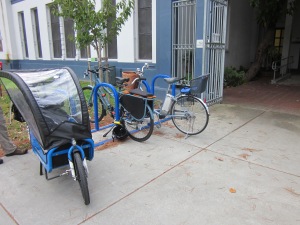On June 3rd I had my final surgery on the leg that was run over. On June 17th, one month ago, I went back to the surgeon’s office to have my staples and bandages removed, and get clearance to walk (and ride a bike) again. The staple removal was uneventful, although painful, and I walked out with permission to do almost everything I could do up until the moment I was hit last April.
This was my last surgical appointment, and it was not without its surprises. “You know, that was a really serious injury,” they said. “Last year we thought you might never walk again! And look at you now!”
WHOA. I understand why they didn’t mention that then, but it was a nauseating thing to hear.
Thanks to good luck and evidently, to clean living, I am walking better now that I was when all the hardware was still in my leg. People at work tell me that my gait is smoother, and they can’t tell I was ever hurt. The office is not the most challenging walking environment, it’s true, but it’s a good sign.
There are still some odds and ends to deal with. Running and jumping are out of the question for the rest of the year. I remain as weak as a kitten when walking up hills and stairs, although I get practice with that here in San Francisco whether I want it or not. I’m not thrilled about the 15 pounds I gained over the last year of reduced activity (but on the up side, now that I’m moving again I’ve already started losing that extra weight). My scars still look pretty grim. I know they’ll fade over time but even so I’ll be wearing long pants for the rest of the year, both because the scars are susceptible to sun damage and because I prefer to cover them given some of the looks I got last year. In the grand scheme of things these issues are pretty trivial, and none of them are permanent.
People still ask me if I was scared to get back on the bike. Honestly, after four months being almost completely immobilized last year, my stir-craziness outweighed any residual fear. I was over it. I couldn’t walk well for months after I was allowed to walk, but I learned pretty quickly that I could ride a bike almost as well as anyone, at least on the flats, and I had an electric assist for the hills. Riding a bike made me feel normal again. I’ll admit that I do still get anxious making left turns—I now make Copenhagen left turns almost all the time.
After several visits to the orthopedic institute, I also have some perspective that I didn’t have before. Basically every patient I saw there under the age of 80, other than me, had been injured in a car.
“My husband was driving when we were sideswiped…”
“I was driving my pickup…”
“Our car rolled over when it went off the road…”
These people were traumatized. They were, understandably, afraid to get back in their cars. They did it anyway, because they felt like they didn’t have a choice. And in some cases they were right, because that’s how the US is designed. But their fear was justified.
What I realized in all those hours racked up waiting to see the surgeon was this: Riding a bicycle isn’t dangerous. What’s dangerous is being around cars. Understanding the real risk involved in transportation has helped me think about how I want to travel most of the time. There are different ways to approach the real risk, the risk of “being around cars.”
One way is to try to wear armor, investing in strategies like driving a bigger car or riding the bus. Sometimes that works and sometimes you end up in the orthopedic institute like all those people I met in the waiting room. Or worse. When I was pregnant with my son, a driver rammed my car from behind while I was stopped at a red light and I spent the next month on bedrest to keep from miscarrying. The more time you spend being around cars, no matter how big the bubble you build around yourself, the greater the risk.
Another way to approach the risk of being around cars is to simply be around cars a lot less. Drivers can’t hit you if you’re hanging out in places cars can’t go. The first step is to cut back on riding in cars: I don’t think it’s a coincidence that my surgeon commutes by bike. A lot of bicycle travel can be through parks, or on quiet streets, or (more recently) in protected bike lanes. In other cities people can legally ride on the sidewalk when cars feel too close or traffic is too fast—and in San Francisco, there are a few scary places where I too will ride on the sidewalk now, even though it’s illegal. Protected infrastructure and its near-equivalents are increasingly common, and they’re worth seeking out. It’s certainly possible to make riding a bicycle really dangerous by getting up close and personal with cars at every opportunity, but there’s no requirement to ride that way.
I chose to be around cars a lot less. That includes staying out of cars when I can, even though it’s not practical for us to avoid them entirely. Active transportation has other rewards as well—I’m a lot healthier, and I healed better than anyone had expected when I was hurt. It’s also the fastest way to move through the city, and it’s always easy to find parking. The greatest reward of all, of course, is that it’s a fun way to get around. I understand now why people who love skiing or rock climbing or hang-gliding accept the very-real risks of their sports, and return from their injuries ready to start all over again. But biking is not like rock climbing—every study of bicycle commuting has found that I’ll live a longer and healthier life, statistically speaking, if I keep riding. And so I do.





























